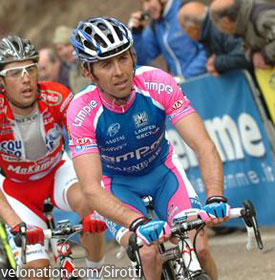 Lampre-Farnese riders Gilberto Simoni and Matteo Bono are travelling to the Trentino province in northern Italy this Thursday to reconnoitre the climb to the 2273 metre Plan de Corones. The already legendary unsurfaced climb will feature in a 12.9km uphill time trial from San Vigilio di Marebbe on stage 16 of next month’s Giro d’Italia, and is expected to be one of the most decisive points of the race.
Lampre-Farnese riders Gilberto Simoni and Matteo Bono are travelling to the Trentino province in northern Italy this Thursday to reconnoitre the climb to the 2273 metre Plan de Corones. The already legendary unsurfaced climb will feature in a 12.9km uphill time trial from San Vigilio di Marebbe on stage 16 of next month’s Giro d’Italia, and is expected to be one of the most decisive points of the race.
‘Gibo’ Simoni recently rejoined the team with whom he won the first of his two Giri d’Italia in the hope of making one more serious attempt at taking a third before he retires. The pair will be travelling in the company of Lampre-Farnese Vini sport director Fabrizio Bontempi.
“Only if you try to pedal on the Plan de Corones climb can you understand how tough it is,” explained Bontempi. “So, this training will be very important in order to understand the proper way to face this stage.”
The Plan de Corones is regarded as one of the toughest climbs in cycling. Not only does its gradient rise up to 24% in some places, but also the road is unsurfaced throughout its 5km length. The course follows the road as it rises from San Vigilio to the top of the 1738 metre Passo Furcia, it then turns off the asphalt road to join the dirt and gravel track to the summit. It can be difficult to perform reconnaissance on the climb as it is often still covered in snow at this time of year.
This year’s race will be the third occasion that the climb has featured; it was introduced in 2006 when Giro organiser RCS Sport decided to add some history to the race by crossing unsurfaced roads. However on that first occasion foul weather forced organisers to end the road stage on the Passo Furcia, before the unsurfaced road starts.
The only time that the pass has actually been raced on was in 2008, where Franco Pellizotti of Liquigas won a time trial stage identical to this year’s. Simoni, riding for the Serramenti PVC Diquigiovanni team, finished third on the stage, 17 seconds behind Pellizotti. Many, if not most, riders used compact chainsets, with chainrings of 50 and 34 teeth instead of the usual 53 and 39, and six riders finished outside the time limit.